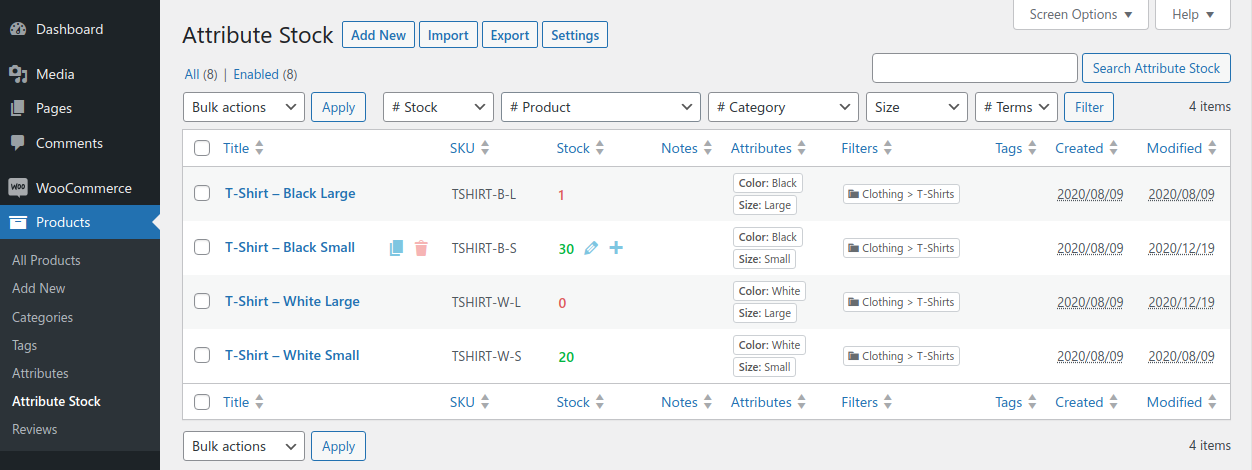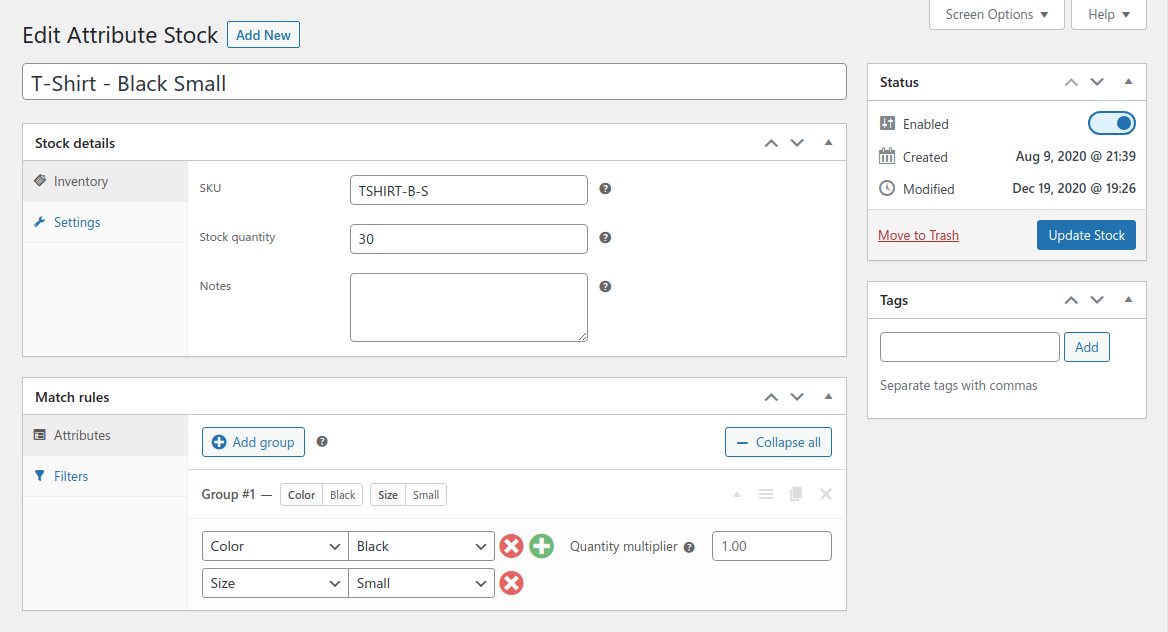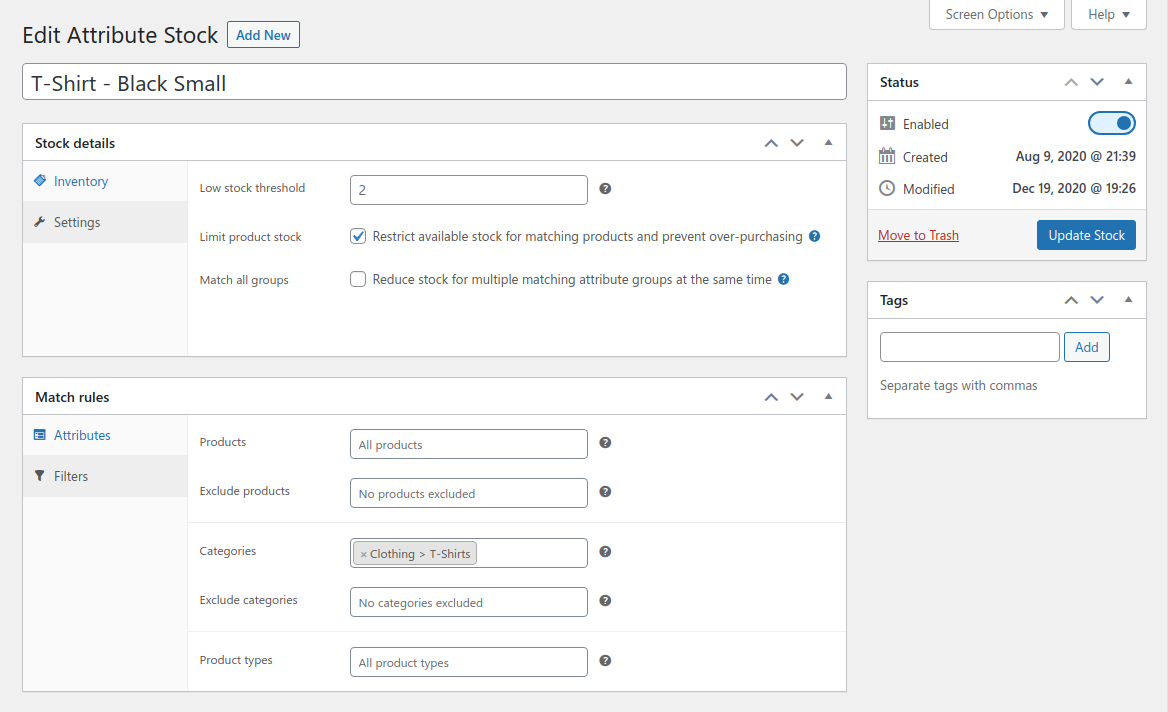# Advanced Usage
# The management interface
WooCommerce Attribute Stock includes a separate user-friendly admin page for advanced management of your attribute stock. It is not intended to replace the native Product Attributes interface, but rather to supplement it with improved management and configurability of your attribute stock inventory.
The advanced interface can be accessed by navigating to Products > Attribute Stock.

From this screen you can add, delete, enable, disable, and duplicate stock items, and well as directly update stock quantities. You also have a number of filtering options to narrow down the list and show only relevant stock items.
# Import / Export
Another important feature on this screen is importing and exporting to/from CSV. This is especially useful when adding or updating a large number of stock items in bulk, as this can be much more efficient to do in a spreadsheet editor.
Exporting your stock data to CSV also allows you to easily spot any mistakes in your configuration. And it doubles as a quick and effective stock report.
When importing a CSV file, attribute stock will attempt to match rows to your current stock items by Title and SKU. If a match is found, the stock item will be updated. Otherwise a new stock item will be created. You can also remove columns entirely from the CSV file to only update specific data.
TIP
To guard against accidental data loss, blank column values will be skipped instead of deleting data for matching stock items. Simply set a cell's value to () if you want it to be removed.
# Managing stock items
Advanced options and settings for attribute stock items can be configured from the Attribute Stock screen. You can easily add new items or editing existing ones.

# Inventory tab
The inventory tab displays the most commonly used fields:
- SKU — Set the internal Stock Keeping Unit for the attribute stock item. Optional.
- Stock quantity — The current stock quantity of the attribute stock item.
- Notes — Internal notes about the attribute stock item.
# Attributes tab
The attributes tab provides a simple yet powerful interface to match attributes or groups of attributes to your stock item. Each attribute match is efficiently queried from top to bottom against product listings.
For example, if a match group is added for Size: Small and Color: Red, then products with BOTH of these attributes assigned will be linked to this attribute stock item.
By default only the first matched group will be considered when reducing stock for a purchased product. Reducing stock for ALL matched groups can be enabled with the Match all groups option.
You may also set a Quantity multiplier per match group. This controls how much stock is reduced per purchase. Setting this field to 0 will force limited products to be out of stock.
# Configuring advanced options

# Settings tab
Additional options can be set for more advanced control of your attribute stock items.
- Low stock threshold — When stock reaches this amount or less, you will be notified by email (if enabled in WooCommerce settings). Stock quantity will be displayed in red instead of green in the Attribute Stock table list. This stock item will also be listed under
Low in stockorOut of stockrespectively in the Attribute Stock report. - Match all groups — With this option enabled, stock will be reduced for every matched attribute group in cases when more than one match occurs for a product/variation. This is an alternative to the default of only reducing stock for the first matched attribute group.
- Limit product stock — This option restricts the available stock for matching products and prevents over-purchasing. This option is required for attribute stock to affect the available product stock on the frontend. It should be disabled for stock items that do not affect the availability of a product. Scroll down for more info on how product stock limiting works.
# Filters tab
One or more filters can be set to narrow down the products that your attribute stock items will match.
- Products — Filter matches to only the specified products.
- Exclude products — Filter matches to all products except the specified products.
- Categories — Filter matches to only products within the specified categories.
- Exclude categories — Filter matches to products within all but the specified categories.
- Product types — Filter matches to only products of the specified type.
# How product stock limiting works
Limiting product stock binds attribute stock to your product's availability, displaying the effective available stock for a product on the frontend and preventing customers from over-purchasing associated attribute stock.
For example, if a product has 50 stock, and it also has an associated attribute with 100 stock, then the product's effective available stock will be 50 (the lower of all associated stock quantities).
If however the product has Manage stock disabled and Stock status is set to In stock, then its product stock is essentially unlimited. But since it still has an associated attribute with 100 stock, the effective available stock will be 100. This is common usage when managing your stock exclusively with attribute stock.
The exception to this is when the product's Stock status is set to On backorder. In this case its available quantity will not be limited by attribute stock as it will allow back-ordering of the product and attribute regardless of stock on hand.
Product stock limiting is enabled by default, but may be disabled per attribute stock item from the advanced edit interface.
TIP
The effective available stock of a product is always the lowest quantity of the product's stock and all matching attribute stocks with Limit product stock enabled.
← Basic Usage REST API →
